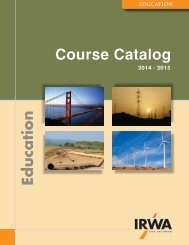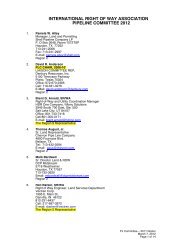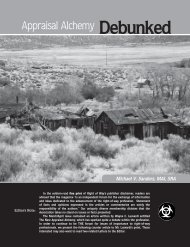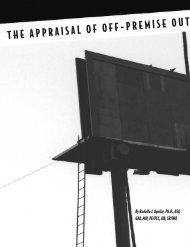SUNRISE POWERLINK - Irwachapter32.org
SUNRISE POWERLINK - Irwachapter32.org
SUNRISE POWERLINK - Irwachapter32.org
Create successful ePaper yourself
Turn your PDF publications into a flip-book with our unique Google optimized e-Paper software.
IRWA’s 2012 Project of the Year<br />
<strong>SUNRISE</strong> <strong>POWERLINK</strong><br />
California’s New Superhighway of Electricity<br />
BY BARBARA BILLITZER<br />
This past June, San Diego Gas & Electric Company (SDG&E)<br />
put into service the Sunrise Powerlink, a 500,000-volt<br />
transmission line linking San Diego to California’s Imperial<br />
Valley, one of the most renewable-rich regions in the state.<br />
The 117-mile electric transmission line will deliver 1,000<br />
megawatts of clean, reliable energy, enough to power 650,000<br />
homes and businesses in San Diego.<br />
The completion of the Sunrise Powerlink project couldn’t have<br />
come at a more critical time. With the San Onofre Nuclear<br />
Generating Station offline for repairs since the beginning of the<br />
year, Southern California’s transmission grid was facing serious<br />
reliability issues. A prolonged shutdown of the San Onofre<br />
Station had the potential to cause customer outages during the<br />
lingering heat waves expected over the summer months.<br />
1 8 R i g h t of Way N O V E M B E R / D E C E M B E R 2 0 1 2
Although the project is officially in operation, it was initially<br />
considered to be one of the most controversial projects in<br />
California. The nearly $1.9 billion project endured a rigorous,<br />
five-year environmental review and permitting process and<br />
more than 75 public hearings. SDG&E adhered to more than<br />
320 environmental mitigation and conservation measures and<br />
permit conditions that were ultimately required as a result of an<br />
11,000 page Environmental Impact Report/Statement.<br />
Comprehensive Study and Regulatory Reviews<br />
When the Sunrise Powerlink was first conceived, it underwent<br />
what is considered to be the most comprehensive study of a<br />
proposed transmission power line in state history. Because<br />
SDG&E is an investor-owned utility in California, it is regulated<br />
by the California Public Utilities Commission (CPUC), the<br />
state agency authorized to issue the final license for public<br />
utility transmission projects and the lead agency for California<br />
Environmental Quality Act compliance. Since the bulk of<br />
the project alignment would ultimately cross lands under the<br />
control of the U.S. Bureau of Land Management (BLM) and<br />
the U.S. Forest Service, the BLM served as the federal lead<br />
agency under the National Environmental Policy Act. Because<br />
the project necessitated a collaborative effort between SDG&E<br />
and a number of state and federal agencies, it was subject to an<br />
extensive regulatory review.<br />
SDG&E initially proposed to build the Sunrise Powerlink<br />
along a northern alignment and focused its efforts on this<br />
route for the first several years of the project. This alignment<br />
was located in the more northern portion of Imperial and San<br />
Diego counties, as opposed to the final southern route that<br />
was ultimately approved by the CPUC and then constructed.<br />
Additionally, through the environmental review process, the<br />
CPUC considered approximately 100 alternative route or route<br />
segments. This significant change in the location of the route and<br />
the timing of this shift contributed to the resulting compressed<br />
project schedule.<br />
Experts had identified the Imperial Valley/Northern Baja<br />
California regions as having huge renewable energy potential, and<br />
studies conducted by California’s Renewable Energy Transmission<br />
Initiative validated the region’s ability to produce solar, geothermal<br />
and wind power. Sunrise was specifically designed to import these<br />
vast sources of renewable energy to accommodate peak demands<br />
and ensure reliability benefits for the region.<br />
The construction of Sunrise was also crucial to SDG&E’s ability<br />
to satisfy a 2002 California mandate that at least 20 percent of<br />
the company’s power come from renewable sources. In 2008,<br />
SDG&E voluntarily agreed to acquire 33 percent of its power<br />
from renewable energy, and over time, this amount became<br />
state law.<br />
The land team supported the project from its inception and<br />
ensured property access for the initial studies of the various<br />
route alternatives. Lynn Trexel, Principal Right of Way Agent for<br />
the Sunrise Powerlink, was part of the initial core project team<br />
At the dedication ceremony at SDG&E’s new Suncrest Substation in July, California<br />
Governor Jerry Brown praised the project for its creation of clean energy and new jobs.<br />
N O V E M B E R / D E C E M B E R 2 0 1 2 R i g h t of Way 19
that was formed in 2005 and tasked with obtaining project<br />
approvals. During the land rights acquisition phase, her team<br />
acquired land rights from nine various federal, state and local<br />
agencies. “Throughout the project we were reminded of just<br />
how important relationships are to the success of any project,”<br />
said Lynn. “We worked hard to develop our agency and<br />
property owner relationships based on open communications<br />
and a foundation of trust.”<br />
Building the Team<br />
“A core team needs to be assembled at the very beginning<br />
stage of a major project and remain with the project until<br />
it’s finished,” noted Gerry Akin, Sunrise Powerlink’s Project<br />
Manager for the overhead segment that spanned 111 miles.<br />
“We recognized that the project would require expertise in<br />
permitting, project management, land rights acquisition,<br />
construction and environmental compliance.”<br />
A representative from each key area was assigned to the team,<br />
including land, environmental, engineering, construction,<br />
legal, regulatory and public affairs, with support from various<br />
contractors. Over time, the team evolved in structure and<br />
composition to meet the needs of each stage of the project.<br />
During the most active phases of the project, there were three<br />
different sub-project teams, including one for the overhead<br />
sections, one for the underground section and one for the<br />
substation. With the sheer size and composition of the<br />
various teams, a tremendous amount of coordination and<br />
communication was needed, particularly during construction.<br />
Prior to the acquisition phase, an in-house team of land agents<br />
was assembled, augmented by right of way contractors, most<br />
of whom were former SDG&E employees. Of the company’s<br />
twelve staff right of way agents, seven were assigned full-time<br />
Roughly six miles had to be built beneath Alpine Boulevard, the main county<br />
road, so SDG&E constructed streetscape improvements to mitigate the<br />
inconvenience to the community.<br />
to Sunrise, and four seasoned contract agents were brought<br />
on board. Since the utility would be a long-term fixture<br />
in the community, it was vital that SDG&E establish good<br />
relationships with property owners early in the process.<br />
SDG&E used the land surveying services from five separate<br />
contractors. Two of the firms supported the land rights<br />
acquisition process, while the other three focused on<br />
project engineering and construction. SDG&E’s in-house<br />
survey contract administrator, also a licensed surveyor,<br />
provided invaluable assistance in interpreting drawings and<br />
legal descriptions, as well as coordinating with the various<br />
contractors.<br />
Looking back, Gerry noted, “The project succeeded<br />
because everyone on the team eagerly stepped up and took<br />
responsibility to get things done. If the initial efforts were<br />
stalled or blocked by events or factors outside our control, the<br />
team quickly identified and pursued alternatives.”<br />
Community Opposition<br />
Early on, SDG&E partnered with the community and openly<br />
communicated information about the route selection and<br />
alternatives analysis. However, the landowners who would<br />
be impacted initially saw no near-term benefit from a line<br />
connecting the desert with the greater San Diego region. They<br />
voiced their concerns about the line’s effect on property values<br />
and appraisals being conducted in a down market, fearing that<br />
lower payments for property rights would result.<br />
In response, the land agents participated in many public<br />
outreach meetings in those communities most affected by<br />
the project. Handouts that outlined owners’ rights and the<br />
property acquisition process were disseminated, and the<br />
agents took time to listen and respond to the owners’ specific<br />
concerns. The agents also made sure to explain the legal<br />
mandate to disregard project influence in valuations, even if it<br />
required analyzing market data and sales in areas distant from<br />
the project. In some instances, agents were able to facilitate<br />
adjustments in the alignment that lessened the impact to<br />
certain properties.<br />
Despite conducting extensive outreach efforts, the project was<br />
still opposed by many in San Diego County. As with other<br />
newly proposed infrastructure, the opponents objected to the<br />
potential direct and indirect impacts on back-country wildlife,<br />
vistas and tribal cultural sites. Several intervenor and volunteer<br />
grassroots groups were formed to try and stop the project. The<br />
anti-project sentiment was further heightened by the publicity<br />
generated by the U.S. Supreme Court’s Kelo decision, which<br />
spawned more owner-friendly eminent domain legislation and<br />
restrictions on condemning agencies.<br />
2 0 R i g h t of Way N O V E M B E R / D E C E M B E R 2 0 1 2
Evolving the Design<br />
However, it is not unusual for a route that spans 117 miles and<br />
passes through two counties to be plagued by design changes.<br />
Some of the environmental mitigation measures required<br />
for the project were not clearly understood up-front, making<br />
it difficult to identify the best way to implement them.This<br />
caused a significant number of design changes along the way,<br />
which ultimately triggered various right of way and appraisal<br />
revisions. In turn, the land team needed more time to explain<br />
the changes to the property owners.<br />
The agents worked collaboratively with design and<br />
environmental personnel to minimize or eliminate changes,<br />
stressing the economic consequence and the negative impact<br />
to the project schedule in having to make right of way and<br />
appraisal revisions. However, many of the design changes were<br />
unavoidable. For those owners where negotiations reached an<br />
impasse, the design changes further hampered the ability to<br />
commence eminent domain proceedings in a timely manner.<br />
A portion of the segment needed to pass through the<br />
downtown business district of Alpine, CA, a town just east<br />
of San Diego. Roughly six miles had to be built beneath<br />
Alpine Boulevard, the main county road, and construction<br />
was estimated to take about 15 months. In mitigating the<br />
inconvenience to the community, SDG&E agreed to construct<br />
streetscape improvements in the form of curbs, gutters,<br />
sidewalks and a rubberized asphalt curb-to-curb surface, in<br />
addition to undergrounding the overhead electric distribution<br />
facilities in much of the area.<br />
Environmental Impacts<br />
The environmental impact statement/report was by far the<br />
largest in California history. SDG&E implemented more than<br />
320 environmental-mitigation and conservation measures and<br />
permit conditions, which required almost 1,000 separate tasks,<br />
including protections for ten special-status species. Some of<br />
the requirements created unprecedented challenges for the<br />
construction team, such as vegetation clearing limitations, bird<br />
nests impacting construction and no-fly zones, narrow flight<br />
corridors and extensive storm water pollution prevention<br />
plans.<br />
For example, construction within an eagle nesting area was<br />
required to be scheduled with pinpoint precision. Safeguarded<br />
by the Bald and Golden Eagle Protection Act, the golden eagle<br />
faces threats ranging from loss of foraging and nesting areas to<br />
pesticide poisoning and collisions with manmade structures.<br />
To protect the golden eagles, a 4,000-foot land and air buffer<br />
zone was instituted around the eagle nesting areas for the sixmonth<br />
period that roughly coincides with eagle reproduction.<br />
For environmental reasons, nearly 75 percent of the construction was performed by<br />
helicopters, and the project logged more than 30,000 flight hours.<br />
All work within the eagle buffer zones needed to be completed<br />
before a mandated cutoff date, forcing construction and<br />
helicopter crews to work at breakneck speed to complete four<br />
key sections before the onset of the eagle nesting season.<br />
In preparation for the Sunrise project, SDG&E trained<br />
more than 400 environmental professionals from eleven<br />
different companies to monitor air quality, fire safety, and<br />
biological, cultural and visual impacts. Pam Fair, SDG&E’s<br />
Vice President of Environmental and Support Services<br />
explained, “For major construction projects, we recognize<br />
that effective management of land rights and environmental<br />
requirements is critical, especially since the laws impacting<br />
these areas have become increasingly complex over time. Our<br />
land, environmental and legal teams were instrumental in<br />
achieving successful outcomes, and their ability to work with<br />
property owners and other key stakeholders demonstrated an<br />
outstanding team effort.”<br />
N O V E M B E R / D E C E M B E R 2 0 1 2 R i g h t of Way 21
Two of the company’s eight renewable contracts under construction are Pattern’s Ocotillo Wind project and Tenaska’s CSolar South solar project, both located in<br />
California’s Imperial County.<br />
Landowner Relations<br />
During the initial project scoping phase, it was estimated that<br />
condemnation would likely be unavoidable for a significant<br />
number of private property ownerships, primarily due to<br />
project opposition, chronic nimbyism and what the land<br />
agents thought was a very optimistic schedule. The agents<br />
understood that their primary objective was to acquire<br />
property rights in a timely manner, preferably without using<br />
their statutory right of eminent domain.<br />
Of the total project alignment, roughly 69 miles are located<br />
on federal lands, seven miles on state and local agency lands<br />
and 30 miles on private property. SDG&E was only able to<br />
utilize its existing right of way and a franchise agreement for<br />
11 miles. The acquisition of land rights from 79 private land<br />
owners and nine agencies on a compressed project schedule<br />
complicated the acquisition timeline and approval process.<br />
According to Jon Taylor, SR/WA, the project’s Land Services<br />
Manager, “We began our negotiations making offers based on<br />
independent appraisals, and we listened to the landowners’<br />
concerns. Yet, because so many of the landowners felt<br />
there was no direct benefit from the project, many of them<br />
opposed our efforts. We were often rebuffed or faced with<br />
unreasonable demands, leaving us no alternative but to file<br />
condemnation. In working closely with our legal team, we<br />
were able to resolve, through negotiations and mediation, all<br />
but one of the cases filed.”<br />
SDG&E’s in-house legal team and outside counsel were key<br />
contributors to the project’s success. “As in-house counsel,<br />
it was my responsibility to provide legal direction on right<br />
of way and property acquisition issues,” said C. Larry Davis,<br />
SDG&E’s Assistant General Counsel. “This began during<br />
the CPUC licensing phase, continued with obtaining precondemnation<br />
access through the courts for conducting<br />
environmental review for California Environmental Quality<br />
Act compliance, to ultimately overseeing the acquisitions<br />
through condemnation. With a project of this magnitude,<br />
our team’s biggest challenge was in coordinating the filing of<br />
eminent domain cases and obtaining orders for possession<br />
with the construction schedule.” Landowner negotiations<br />
resulted in the condemnation of half of the number of cases<br />
originally projected and many filings occurred for reasons<br />
other than compensation.<br />
According to Peter McMorris, SR/WA, R/W-NAC, Principal<br />
Right of Way Agent for the Sunrise Powerlink, “Winning the<br />
trust of property owners was one of the land team’s greatest<br />
challenges. It required overcoming project resentment, doubts<br />
about fairness of compensation and cynicism regarding<br />
the company’s objectives and motives.” All in all, a familiar<br />
challenge facing many of today’s right of way professionals.<br />
“The team’s ability to manage those factors over which they<br />
had little or no control really made a difference,” said Peter.<br />
“From design changes to mitigation requirements to issues<br />
raised by owners and their legal counsel, I commend the<br />
project team for their thorough preparation, follow-up and<br />
empathy, all of which helped them to effectively work through<br />
a range of diverse acquisition and valuation challenges.”<br />
By reviewing land survey data, project mapping and property ownership, the land<br />
team was able to confirm the most feasible routes and land rights required. From<br />
left, Land Surveyor Pete Tkachuk, PLS and Right of Way Agents Fred Clark, SR/WA,<br />
Lisa Murphy, SR/WA and Paul Nussbaum, SR/WA.<br />
2 2 R i g h t of Way N O V E M B E R / D E C E M B E R 2 0 1 2
Although the negotiations were ever-challenging, Sunrise’s<br />
land acquisition efforts resulted in the development of many<br />
positive relationships with property owners and agencies.<br />
One example of poignant relationship-building involved a<br />
property owner in El Centro, CA. Greg Mayo, SR/WA, one<br />
of the project’s right of way agents, not only acquired an<br />
easement but through the process acquired a new “mom.”<br />
The landowner’s husband had bought their desert property<br />
decades ago before they were married, and she had only<br />
been there one time many years ago. Greg went above and<br />
beyond what was normally required to make sure she clearly<br />
understood all of the detailed information. He even picked<br />
her up from her home and drove her to the property, stopping<br />
for lunch along the way. She was thrilled to see it again.<br />
They developed quite a rapport that day and in the months<br />
that followed, she got to know Greg even better. As a result,<br />
she began treating Greg like her own son, sending him and<br />
his family cards for their birthdays. In one card she wrote,<br />
“My dear son Greg, I thank the Lord so much for giving me<br />
another son. God bless you and your whole family always.”<br />
Renewable Energy Potential<br />
Upon its completion, the Sunrise Powerlink was turned<br />
over to the California Independent System Operator, the<br />
state’s transmission grid operator. Now providing increased<br />
reliability to the region, the line will soon deliver a significant<br />
amount of wind and solar power.<br />
Over the past three years, SDG&E has signed eight<br />
renewable contracts for more than 1,000 megawatts of solar<br />
and wind energy in Imperial County to be transmitted<br />
across the transmission line. While the eight projects all<br />
have different permitting and construction timelines, two<br />
projects, Pattern Energy’s Ocotillo Express Wind project and<br />
Tenaska’s CSolar South solar project, are currently under<br />
construction in Imperial County. SDG&E has also signed<br />
other renewable contracts for projects in eastern San Diego<br />
County, which are made possible by the additional capacity<br />
created by the Sunrise Powerlink.<br />
The area of east San Diego County, along with neighboring<br />
Imperial County and Northern Baja California, has a<br />
potential aggregate generating capacity of roughly 6,870<br />
megawatts for solar energy, 3,495 megawatts for wind power<br />
and 2,000 megawatts for geothermal energy. Together, these<br />
renewable resources could potentially produce enough<br />
electricity to power eight million homes. This will help<br />
meet several state and federal policies and mandates for the<br />
increased use of green energy, including President Obama’s<br />
New Energy for America Plan, which seeks to ensure that<br />
25 percent of the country’s electricity comes from renewable<br />
sources by 2025. Roughly $6.5 billion included in the<br />
American Recovery and Reinvestment Act is intended<br />
to provide tax relief and other incentives to develop the<br />
infrastructure necessary to move renewable energy from<br />
rural production areas to urban markets.<br />
SDG&E’s President and COO Michael Niggli and Pam Fair, SDG&E’s Vice<br />
President of Environmental and Support Services.<br />
A Sense of Pride<br />
Constructing the 117-mile transmission line took 18 months<br />
of construction and more than 4.7 million work hours. To<br />
put things into perspective, this is the equivalent of 2,260<br />
people working 40 hours a week for an entire year. During<br />
construction, the project team endured months of overhead<br />
and underground construction through rough, remote<br />
terrain.<br />
“As we compressed the construction timeline from 24<br />
months to just 18 months, completing the project on budget<br />
and on schedule is a true testament to our employees,” said<br />
Patrick Lee, Sunrise Powerlink’s Vice President of Design<br />
and Construction. “The land agents worked proactively to<br />
match the priorities of project construction with appraisal<br />
assignments, acquisition and commencement of eminent<br />
domain proceedings. I am proud of their diligence,<br />
dedication and commitment to safety, while at the same<br />
time complying with hundreds of environmental mitigation<br />
measures that were required.”<br />
During the dedication ceremony, Michael R. Niggli,<br />
President and Chief Operating Officer of SDG&E said, “We<br />
faced significant challenges in constructing this project<br />
which will enable clean, renewable energy to be transported<br />
from the desert to urban coastal communities of southern<br />
California. Due to the team’s outstanding efforts, we were<br />
able to ensure that the Sunrise Powerlink was put into<br />
service just in time to meet energy shortfalls due to San<br />
Onofre Nuclear Generating Station being offline and the<br />
summertime’s high power demands. Our employees came<br />
through when it was critical to the community, and everyone<br />
who worked on the project feels a sense of pride and<br />
accomplishment in its completion.”<br />
N O V E M B E R / D E C E M B E R 2 0 1 2 R i g h t of Way 23
















